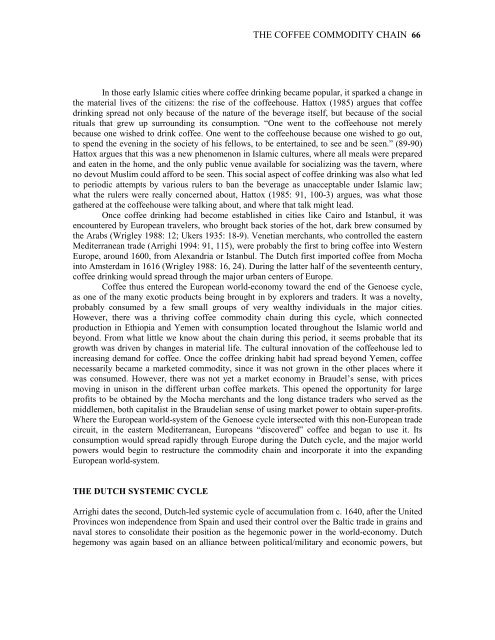Entire Volume 17 issue 1 - Journal of World-Systems Research ...
Entire Volume 17 issue 1 - Journal of World-Systems Research ...
Entire Volume 17 issue 1 - Journal of World-Systems Research ...
You also want an ePaper? Increase the reach of your titles
YUMPU automatically turns print PDFs into web optimized ePapers that Google loves.
THE COFFEE COMMODITY CHAIN 66<br />
In those early Islamic cities where c<strong>of</strong>fee drinking became popular, it sparked a change in<br />
the material lives <strong>of</strong> the citizens: the rise <strong>of</strong> the c<strong>of</strong>feehouse. Hattox (1985) argues that c<strong>of</strong>fee<br />
drinking spread not only because <strong>of</strong> the nature <strong>of</strong> the beverage itself, but because <strong>of</strong> the social<br />
rituals that grew up surrounding its consumption. “One went to the c<strong>of</strong>feehouse not merely<br />
because one wished to drink c<strong>of</strong>fee. One went to the c<strong>of</strong>feehouse because one wished to go out,<br />
to spend the evening in the society <strong>of</strong> his fellows, to be entertained, to see and be seen.” (89-90)<br />
Hattox argues that this was a new phenomenon in Islamic cultures, where all meals were prepared<br />
and eaten in the home, and the only public venue available for socializing was the tavern, where<br />
no devout Muslim could afford to be seen. This social aspect <strong>of</strong> c<strong>of</strong>fee drinking was also what led<br />
to periodic attempts by various rulers to ban the beverage as unacceptable under Islamic law;<br />
what the rulers were really concerned about, Hattox (1985: 91, 100-3) argues, was what those<br />
gathered at the c<strong>of</strong>feehouse were talking about, and where that talk might lead.<br />
Once c<strong>of</strong>fee drinking had become established in cities like Cairo and Istanbul, it was<br />
encountered by European travelers, who brought back stories <strong>of</strong> the hot, dark brew consumed by<br />
the Arabs (Wrigley 1988: 12; Ukers 1935: 18-9). Venetian merchants, who controlled the eastern<br />
Mediterranean trade (Arrighi 1994: 91, 115), were probably the first to bring c<strong>of</strong>fee into Western<br />
Europe, around 1600, from Alexandria or Istanbul. The Dutch first imported c<strong>of</strong>fee from Mocha<br />
into Amsterdam in 1616 (Wrigley 1988: 16, 24). During the latter half <strong>of</strong> the seventeenth century,<br />
c<strong>of</strong>fee drinking would spread through the major urban centers <strong>of</strong> Europe.<br />
C<strong>of</strong>fee thus entered the European world-economy toward the end <strong>of</strong> the Genoese cycle,<br />
as one <strong>of</strong> the many exotic products being brought in by explorers and traders. It was a novelty,<br />
probably consumed by a few small groups <strong>of</strong> very wealthy individuals in the major cities.<br />
However, there was a thriving c<strong>of</strong>fee commodity chain during this cycle, which connected<br />
production in Ethiopia and Yemen with consumption located throughout the Islamic world and<br />
beyond. From what little we know about the chain during this period, it seems probable that its<br />
growth was driven by changes in material life. The cultural innovation <strong>of</strong> the c<strong>of</strong>feehouse led to<br />
increasing demand for c<strong>of</strong>fee. Once the c<strong>of</strong>fee drinking habit had spread beyond Yemen, c<strong>of</strong>fee<br />
necessarily became a marketed commodity, since it was not grown in the other places where it<br />
was consumed. However, there was not yet a market economy in Braudel’s sense, with prices<br />
moving in unison in the different urban c<strong>of</strong>fee markets. This opened the opportunity for large<br />
pr<strong>of</strong>its to be obtained by the Mocha merchants and the long distance traders who served as the<br />
middlemen, both capitalist in the Braudelian sense <strong>of</strong> using market power to obtain super-pr<strong>of</strong>its.<br />
Where the European world-system <strong>of</strong> the Genoese cycle intersected with this non-European trade<br />
circuit, in the eastern Mediterranean, Europeans “discovered” c<strong>of</strong>fee and began to use it. Its<br />
consumption would spread rapidly through Europe during the Dutch cycle, and the major world<br />
powers would begin to restructure the commodity chain and incorporate it into the expanding<br />
European world-system.<br />
THE DUTCH SYSTEMIC CYCLE<br />
Arrighi dates the second, Dutch-led systemic cycle <strong>of</strong> accumulation from c. 1640, after the United<br />
Provinces won independence from Spain and used their control over the Baltic trade in grains and<br />
naval stores to consolidate their position as the hegemonic power in the world-economy. Dutch<br />
hegemony was again based on an alliance between political/military and economic powers, but





